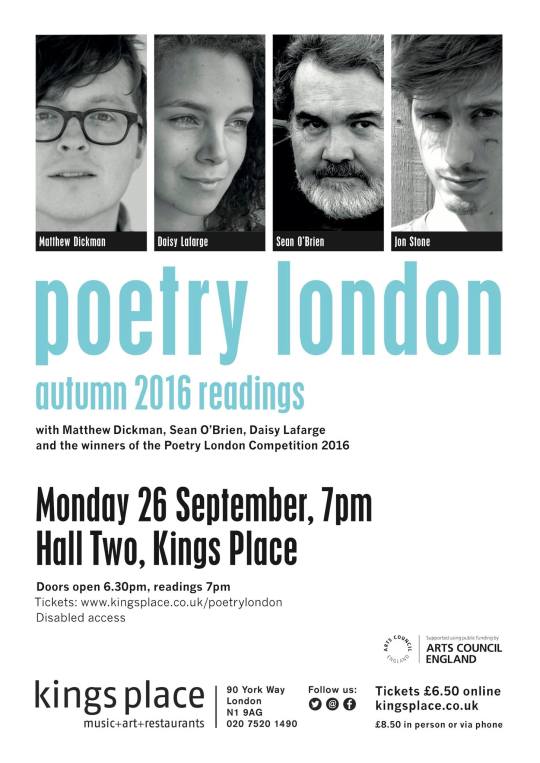I have won this year’s Poetry London competition, judged by Sean O’Brien, and I’ll be reading the winning poem at the following event in September (that’s me on the right, see, with my name underneath my face):

The poem is called ‘The Self-Made Man’. You can read it on the Poetry London website
–
but before you do, understand that web formatting has not been kind to it. It’s not supposed to be double-spaced and the stanza breaks have been missed out. To read it as intended, you may have to wait until the print edition of the next issue hits the shelves.
In game design, they have a thing called a design document, which describes in detail the game’s structure, components, selling points and so on, and I thought this would be a useful format through which I might go into some detail about the poem. So here goes:
Overview
‘The Self-Made Man’ is a poem written originally as a birthday present for my partner, Abigail Parry. As requested, it is a poem about a monster. But what monster? Vincent Price’s Hammer character, the Abominable Dr Phibes, in one sense, but in another sense, the kind of men who find they have the power to shape the world, and become addicted to that power.
Genre
Possibly a monster poem. Possibly a political poem. Shades of dramatic monologue.
Target demographic
Readers with a taste for the uncanny, gothy/gothic imagery, and allusions to the stage as a place of both artifice and transformation.
Perspective
First-person, as told to a confidante or diarised. Introspective, but self-satisfied.
Tone
Mounting megalomania.
Structure
Halting, shorter lines, sometimes with space to emphasises pauses. It should feel like a voice working its way toward complete conviction.
Plot points
(SPOILERS) The poem borrows images and ideas from the film The Abominable Dr Phibes. In the film, Phibes reconstructs his face after an accident (off-screen – his ‘real’ face is a final reel reveal). He then proceeds to exact elaborate, flashy revenge on the medical staff who failed to save the life of his wife, culminating in a scene where he hides a key inside the heart of a doctor’s son. The key is needed to unlock the boy’s bonds and save him from death by acid. Phibes looks like a shabby magician, and he also plays an organ which descends into the floor.
In the poem, the facial reconstruction is the first centrepiece. This needs to be built up carefully to mirror the methodical nature of process it describes. The business about his wife is dropped – this is superfluous to the poem. Reconstructing his face and his voice leads him to realise that anything can be manipulated to his liking. Phibes’ organ, in the poem, is his conviction. He does not see himself as an evil sorcerer, but a craftsman and illusionist. The world is his stage. At the end, his heart is descending like the Phibes’ organ, with the key inside it. (The key to what?)
Themes
Fluidity of fact/truth as empowerment, as drug. Our potentially limitless malleability as blind spot. Monsters are real etc.
Other notable points
In the film, Phibes kills someone with locusts. This is alluded to in the line about ‘minute and delicate jaws’, but it becomes a way of describing how small manipulations effect change (a ripple effect?).
The title is from one of the posters used to advertise the film. The wordplay is now reversed, or rather, brought full circle. It describes a literal ‘self-made man’ but also the social creature we call a self-made man, which is also what the poem is about.
Hopefully, the poem avoids over-stressing the mask imagery – this is very well-worn territory.